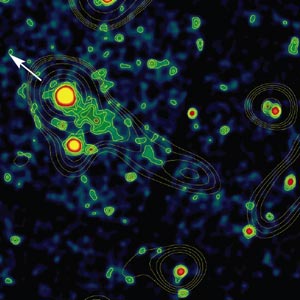Observations of old pulsars by the European Space Agency’s XMM-Newton satellite fail to detect the 1 million-degree hot spots seen around the pole of younger pulsars. The absence of polar X-ray emission in old pulsars casts doubt on the belief that hot spots are produced when charged particles collide with the pulsar’s surface at the poles. It suggests instead that the hot spots are heated from inside the neutron star.

Pulsars are strongly magnetized spinning neutron stars, which emit pulsed radiation, first detected at radio frequencies by Cambridge astronomers Jocelyn Bell-Burnell and Anthony Hewish in 1967. Almost 40 years later, these extremely dense stars, which have roughly the mass of the Sun squeezed into a sphere of only about 20 km across, still hold many mysteries. Astronomers think that neutron stars are formed with temperatures of more than a billion degrees (1012 K) during the collapse of massive stars.
Observations with previous X-ray satellites have shown that the X-rays from cooling neutron stars come from three regions of the pulsar. First, the whole surface is so hot that it emits X-rays. Second, there are charged particles in the pulsar’s magnetic surroundings that also emit X-rays as they move outwards, along the magnetic field lines. Third, younger pulsars show X-ray hot-spots at their magnetic poles.
Until now, astronomers believed that the hot spots are heated by the collision of surrounding particles onto the surface of the neutron star. This happens naturally at the poles owing to the channelling of the charged particles along the magnetic field lines. Such a process is expected to be rather independent of the temperature and hence the age of the pulsar. However, this is not what the XMM-Newton satellite observed for five pulsars. Werner Becker from the Max-Planck Institut für Extraterrestrische Physik (MPE) in Garching and collaborators found no evidence of surface emission, nor of polar hot spots in these pulsars, although they did see emission from the outwardly moving particles.
The lack of surface emission is not surprising because these older pulsars have had several million years to cool down to less than 500,000 °C, the temperature below which they become undetectable by XMM-Newton. However, the lack of polar hot spots is a surprise and means that the particle bombardment of the polar surface is not efficient enough to produce a significant thermal X-ray component.
The XMM-Newton results show that the hot spots fade from view in the same way as the surface-wide emission, thus suggesting a link with the temperature inside the neutron star. As the heat trapped in the pulsar since its birth is carried by electrons, it can be guided to the poles by the intense magnetic field within the pulsar. The new XMM-Newton results support this alternative theory for the origin of the hot spots at the poles of young pulsars. It would mean that the energy heating these polar regions comes predominantly from within the pulsar, rather than from the collision of particles from outside the pulsar.
Further reading
Werner Becker et al. 2006 Astrophysical Journal 645 1421.





